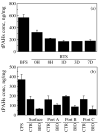Evaluating the effects of bioremediation on genotoxicity of polycyclic aromatic hydrocarbon-contaminated soil using genetically engineered, higher eukaryotic cell lines
- PMID: 22443351
- PMCID: PMC3348858
- DOI: 10.1021/es300020e
Evaluating the effects of bioremediation on genotoxicity of polycyclic aromatic hydrocarbon-contaminated soil using genetically engineered, higher eukaryotic cell lines
Abstract
Bioremediation is one of the commonly applied remediation strategies at sites contaminated with polycyclic aromatic hydrocarbons (PAHs). However, remediation goals are typically based on removal of the target contaminants rather than on broader measures related to health risks. We investigated changes in the toxicity and genotoxicity of PAH-contaminated soil from a former manufactured-gas plant site before and after two simulated bioremediation processes: a sequencing batch bioreactor system and a continuous-flow column system. Toxicity and genotoxicity of the residues from solvent extracts of the soil were determined by the chicken DT40 B-lymphocyte isogenic cell line and its DNA-repair-deficient mutants. Although both bioremediation processes significantly removed PAHs from the contaminated soil (bioreactor 69% removal, column 84% removal), bioreactor treatment resulted in an increase in toxicity and genotoxicity over the course of a treatment cycle, whereas long-term column treatment resulted in a decrease in toxicity and genotoxicity. However, when screening with a battery of DT40 mutants for genotoxicity profiling, we found that column treatment induced DNA damage types that were not observed in untreated soil. Toxicity and genotoxicity bioassays can supplement chemical analysis-based risk assessment for contaminated soil when evaluating the efficacy of bioremediation.
Figures




Similar articles
-
Aerobic Bioremediation of PAH Contaminated Soil Results in Increased Genotoxicity and Developmental Toxicity.Environ Sci Technol. 2015 Dec 1;49(23):13889-98. doi: 10.1021/acs.est.5b00499. Epub 2015 Jul 22. Environ Sci Technol. 2015. PMID: 26200254 Free PMC article.
-
AhR agonist and genotoxicant bioavailability in a PAH-contaminated soil undergoing biological treatment.Environ Sci Pollut Res Int. 2009 Jul;16(5):521-30. doi: 10.1007/s11356-009-0121-9. Epub 2009 Mar 19. Environ Sci Pollut Res Int. 2009. PMID: 19296140
-
Bioavailability of (Geno)toxic Contaminants in Polycyclic Aromatic Hydrocarbon-Contaminated Soil Before and After Biological Treatment.Environ Eng Sci. 2014 Apr 1;31(4):176-182. doi: 10.1089/ees.2013.0409. Environ Eng Sci. 2014. PMID: 24803838 Free PMC article.
-
Implications of Bioremediation of Polycyclic Aromatic Hydrocarbon-Contaminated Soils for Human Health and Cancer Risk.Environ Sci Technol. 2017 Sep 5;51(17):9458-9468. doi: 10.1021/acs.est.7b02956. Epub 2017 Aug 24. Environ Sci Technol. 2017. PMID: 28836766 Free PMC article. Review.
-
Genetically engineered microbial remediation of soils co-contaminated by heavy metals and polycyclic aromatic hydrocarbons: Advances and ecological risk assessment.J Environ Manage. 2021 Oct 15;296:113185. doi: 10.1016/j.jenvman.2021.113185. Epub 2021 Jul 6. J Environ Manage. 2021. PMID: 34243092 Review.
Cited by
-
Formation of PAH Derivatives and Increased Developmental Toxicity during Steam Enhanced Extraction Remediation of Creosote Contaminated Superfund Soil.Environ Sci Technol. 2019 Apr 16;53(8):4460-4469. doi: 10.1021/acs.est.8b07231. Epub 2019 Apr 8. Environ Sci Technol. 2019. PMID: 30957485 Free PMC article.
-
Homologous Recombination and Translesion DNA Synthesis Play Critical Roles on Tolerating DNA Damage Caused by Trace Levels of Hexavalent Chromium.PLoS One. 2016 Dec 1;11(12):e0167503. doi: 10.1371/journal.pone.0167503. eCollection 2016. PLoS One. 2016. PMID: 27907204 Free PMC article.
-
Improving Polycyclic Aromatic Hydrocarbon Biodegradation in Contaminated Soil Through Low-Level Surfactant Addition After Conventional Bioremediation.Environ Eng Sci. 2016 Sep 1;33(9):659-670. doi: 10.1089/ees.2016.0128. Environ Eng Sci. 2016. PMID: 27678476 Free PMC article.
-
Aerobic Bioremediation of PAH Contaminated Soil Results in Increased Genotoxicity and Developmental Toxicity.Environ Sci Technol. 2015 Dec 1;49(23):13889-98. doi: 10.1021/acs.est.5b00499. Epub 2015 Jul 22. Environ Sci Technol. 2015. PMID: 26200254 Free PMC article.
-
Nontarget Analysis Reveals a Bacterial Metabolite of Pyrene Implicated in the Genotoxicity of Contaminated Soil after Bioremediation.Environ Sci Technol. 2017 Jun 20;51(12):7091-7100. doi: 10.1021/acs.est.7b01172. Epub 2017 May 30. Environ Sci Technol. 2017. PMID: 28510420 Free PMC article.
References
-
- White PA. The genotoxicity of priority polycyclic aromatic hydrocarbons in complex mixtures. Mutat. Res. 2002;515(1-2):85–98. - PubMed
-
- Xue WL, Warshawsky D. Metabolic activation of polycyclic and heterocyclic aromatic hydrocarbons and DNA damage: A review. Toxicol. Appl. Pharmacol. 2005;206(1):73–93. - PubMed
-
- USEPA . Cleaning up the nation’s waste sites: Markets and technology trends. 2004 Edition. United States Environmental Protection Agency; Washington, DC: 2004. EPA/542/R/04/015.
-
- USEPA . Treatment technologies for site cleanup: Annual status report. United States Environmental Protection Agency; Washington, DC: 2007. EPA/542/R/07/012.
-
- USEPA . Supplementary guidance for conducting health risk assessment of chemical mixtures. United States Environmental Protection Agency; Washington, DC: 2000. EPA/630/R/00/002.
Publication types
MeSH terms
Substances
Grants and funding
LinkOut - more resources
Full Text Sources

